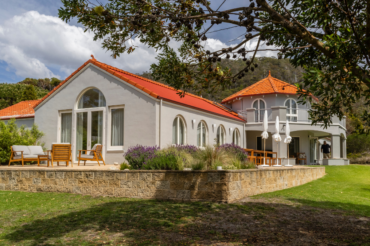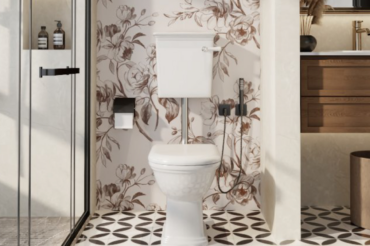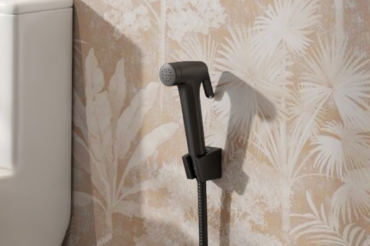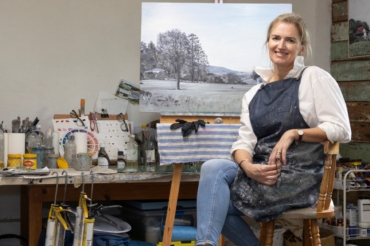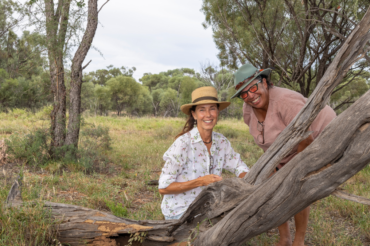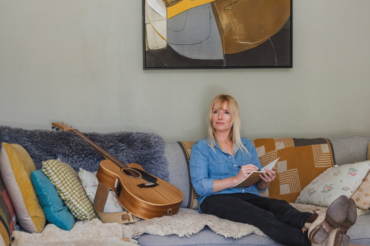
Outback sculptor Milynda Rogers confesses she had no intention of creating the world’s largest outdoor sculpture exhibition when she started planting her works along the road to her home on a station in central-western Queensland.
In fact, her initial motivation was to craft a few scrap metal and barbed-wire features to alleviate boredom for her daughters and neighbours’ kids when they were travelling to their nearest town of Aramac. “My girls were doing school by Distance Ed and that involved a lot of driving, so I did it to give people travelling the route something to look out for,” she says. “When I’d done about 10 sculptures, someone told me people were driving out specifically to see them and I thought I’d better make it worth their while.

So I kept going and now there are 41 sculptures in total. I keep saying I’m going to stop, but then there’s always another idea that pops into my mind.” When she started in 2009, Milynda and her family lived on Boongoondoo station north-east of Aramac on a back road to Jericho. She now lives on a rural residential block near the region’s administrative centre of Barcaldine, where she works on commissions and also serves as the council’s deputy mayor. The self-titled ‘scrap metal sheila’ uses an extraordinary array of materials ranging from barbed wire, discarded machinery parts, horseshoes and trampoline and mattress springs to bits of chain, old tools, even the brushes from street sweeping machinery to create her works, which range in size from a couple of metres to giant-scale.
The works are displayed on a circuit route through the bush, which covers slightly more than 200 kilometres. It can be accessed via the towns of Jericho or Aramac, but visitors who don’t want to venture off sealed roads should stick to the first 68km section north of Aramac, which heads to a local watersports, fishing and bird-watching destination, Lake Dunn, known to locals as ‘The Lake’. En route they will pass her works including a tandem pushbike with kangaroos carrying a goanna, renditions of bushranger Harry Redford and footballer Jonathan Thurston, a pair of jabirus, an echidna and an outsized yabby.

This section of the trail includes the spring fish sculpture, the only work on the circuit that’s not Milynda’s. It was created by students and scientists working on Edgbaston Reserve, where the tiny endangered red-finned blue eye and the rare Edgbaston goby live in the artesian springs of a former cattle station. There are cabins and powered and unpowered camping sites at The Lake, and from there, travellers can either retrace their route to Aramac or head off for a further 140km on dirt roads where the bulk of the sculptures are displayed.
On the way they’ll pass a cowgirl on a cutting horse, butterflies, a koala and a goanna up trees, a bottle tree with cattle ear tags for leaves and an eagle and snake. Reaching a junction, travellers can head for Jericho (about 70km with no sculptures to break the journey), or continue 77km back to Aramac, where they’ll pass a motorbike musterer, a returned soldier perched on an escarpment, an eagle and chicks and fighting red roos. While 4WD or all-wheel-drive vehicles are recommended for the dirt roads, with appropriate caution the entire route could be covered in a conventional vehicle. Travellers should be aware that mobile reception is available in the towns, but elsewhere is either non-existent or at best, patchy.

Fuel up and check the road conditions before you leave town, carry plenty of water and pack lunch to enjoy the circuit at leisure. To do the entire route justice, allow about five hours. It is an extraordinary privilege to see the evolution of Milynda’s work, from self-taught amateur sculptor to a highly skilled professional whose commissions include a life-sized dinosaur and workshops all over the countryside. “I dabbled in sculpture at school, but didn’t do any formal training,” she says. “Then I saw a barbed-wire ball at Blackall and I thought I’d give that a go. From there, I started working in more barbed wire and scrap metal, but it wasn’t until I was commissioned to do a life-sized Muttaburrasaurus that I took it to the next level. When I found out it was seven metres long, I realised I needed to learn how to weld.
So with advice from a local mechanic and lots of instruction from YouTube, I taught myself.” Milynda adds that she also studied visual arts via open learning and completed two years of an engineering degree, but stopped when her studies ventured into “hydro and pumps and stuff that wasn’t relevant”. As her work became better known, friends, neighbours and total strangers starting donating scrap metal to her cause. These days she has a metal maze out the back of her workshop, where all the materials are carefully stored waiting to be recycled into new creations. “Barbed wire is increasingly difficult to get,” she explains. “Not so much of it is used these days and many station people buried their wire when they replaced their fences.” She says that a half-metre diameter barbed wire ball needs about 150 metres of the thorny material, while the Muttaburrasaurus took 3km of wire.

Although Milynda says the sculpture trail is “pretty much complete” she’s keen to add a depiction of Nat Buchanan, who was one of the original explorers of the area. “I recently read a book about him written by his son,” she says. “It’s a tough read because Buchanan took an Aboriginal tracker with him and because he wasn’t always a willing companion, he was chained to a camel. I keep thinking ‘why weren’t we taught this at school?’ So I plan to show the whole story with Buchanan on his horse and the tracker and the camel. I know it doesn’t change history but at least it will tell the truth.”
When Australian Country visited Milynda, work on this project was on hold, while she recovers from back surgery. But she is keen to return to it and has plans to open her studio shed to the public, with picnic facilities and a short track punctuated by sculptures for kids to enjoy. Emus are one of her favourite animals, so already she has installed a few in the paddock. She may even one day open a gallery. Judging from the pile of metal stored in her backyard, the ‘scrap metal sheila’ is not done yet.
For more information, visit Barcaldine


